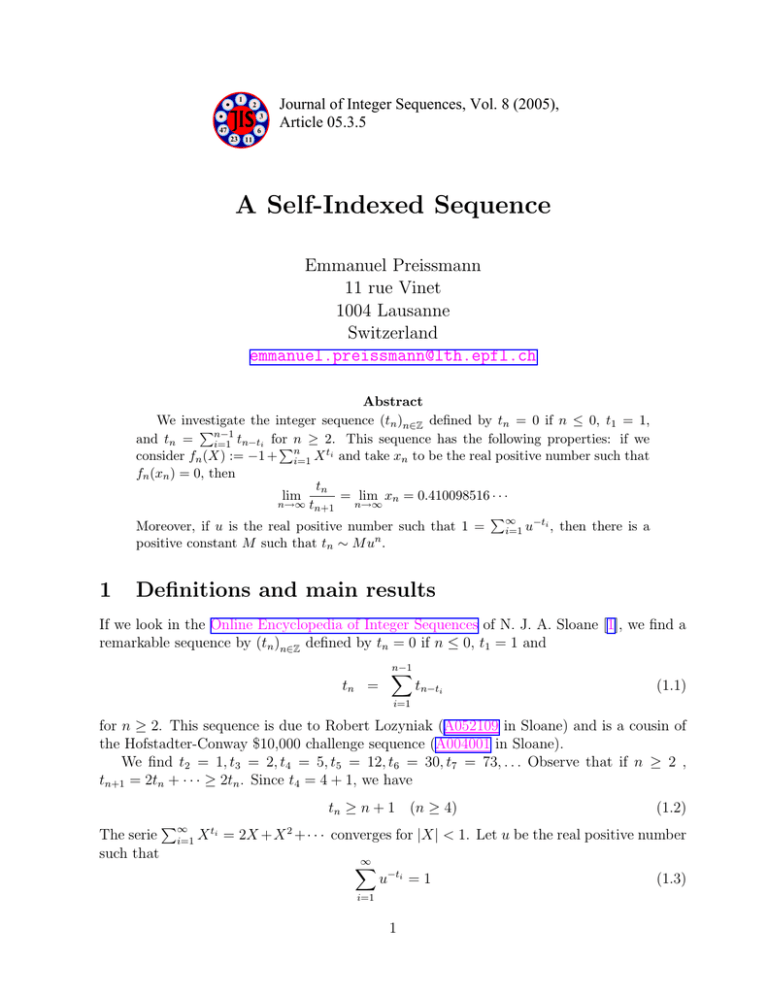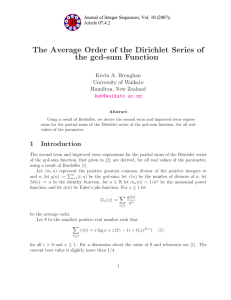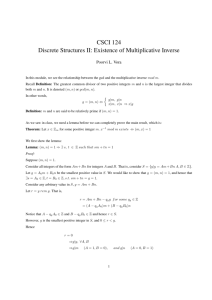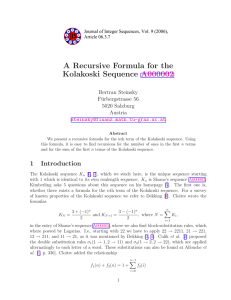A Self-Indexed Sequence Emmanuel Preissmann 11 rue Vinet 1004 Lausanne
advertisement

1 2 3 47 6 Journal of Integer Sequences, Vol. 8 (2005), Article 05.3.5 23 11 A Self-Indexed Sequence Emmanuel Preissmann 11 rue Vinet 1004 Lausanne Switzerland emmanuel.preissmann@lth.epfl.ch Abstract We investigate the integer sequence (tn )n∈Z defined by tn = 0 if n ≤ 0, t1 = 1, Pn−1 and tn = i=1 tn−ti for Pn ≥ 2. This sequence has the following properties: if we consider fn (X) := −1 + ni=1 X ti and take xn to be the real positive number such that fn (xn ) = 0, then tn lim = lim xn = 0.410098516 · · · n→∞ n→∞ tn+1 P −ti , then there is a Moreover, if u is the real positive number such that 1 = ∞ i=1 u positive constant M such that tn ∼ M un . 1 Definitions and main results If we look in the Online Encyclopedia of Integer Sequences of N. J. A. Sloane [1], we find a remarkable sequence by (tn )n∈Z defined by tn = 0 if n ≤ 0, t1 = 1 and tn = n−1 X tn−ti (1.1) i=1 for n ≥ 2. This sequence is due to Robert Lozyniak (A052109 in Sloane) and is a cousin of the Hofstadter-Conway $10,000 challenge sequence (A004001 in Sloane). We find t2 = 1, t3 = 2, t4 = 5, t5 = 12, t6 = 30, t7 = 73, . . . Observe that if n ≥ 2 , tn+1 = 2tn + · · · ≥ 2tn . Since t4 = 4 + 1, we have tn ≥ n + 1 (n ≥ 4) The serie such that P∞ i=1 (1.2) X ti = 2X +X 2 +· · · converges for |X| < 1. Let u be the real positive number ∞ X u−ti = 1 i=1 1 (1.3) We easily see that 2 < u < 3. Indeed we have P ¡ 1 ¢i 5 2 + 19 ∞ = 6. i=0 3 3 P∞ ¡ 1 ¢t i i=1 2 = 21 + 12 + · · · > 1 and P∞ ¡ 1 ¢t i i=1 3 < Theorem 1.1. There exists a positive constant M such that tn = M. n→∞ un lim Corollary 1.1. Let n ≥ 2 be an integer. Let fn (X) = −1 + positive number such that fn (xn ) = 0. Then lim tn n→∞ tn+1 = Pn i=1 X ti and take xn the real 1 = lim xn = 0.410098516 · · · . u n→∞ tn Proof. By the theorem, tn ∼ M un , therefore limn→∞ tn+1 = u1 . In addition, the sequence (xn )∞ n=1 is strictly decreasing. Indeed, n X xtni = 1 = i=1 so that n+1 X i xtn+1 i=1 n X ¡ ti ¢ tn+1 xn+1 − xtni = −xn+1 <0 i=1 This proves that xn+1 < xn for every n. Moreover, this is bounded, so it converges P∞sequence ti to an element, say v. The function f∞ (x) = −1 + i=1 x is continuous. Let ² > 0. We have ∞ X 0 < f∞ (xn ) = xtni < ² i=n+1 if n is big enough. Finally, f∞ (v) = lim f∞ (xn ) = 0. n→∞ That is, v = 2 1 , u because 1 u is the only positive zero of f∞ . Proof of the Theorem We begin with a lemma: Lemma 2.1. If 0 ≤ vn < 1 for every integer n > 0, then the following inequalities are equivalent ∞ X vn < ∞ (2.1) (1 − vn ) > 0. (2.2) n=1 ∞ Y n=1 2 Proof. Without loss of generality, we can suppose that vn ≤ 21 . If an infinite number of vn > 12 , the claims 2.1 and 2.2 are both wrong, otherwise we can take out the finite number of vn > 12 . By Taylor expansion, we have for 0 ≤ x ≤ 12 1 x2 , − log(1 − x) = x + 2 (1 − θx)2 0 ≤ θ ≤ 1; hence x ≤ − log(1 − x) ≤ 2x for 0 ≤ x ≤ 12 . It follows that for every integer N > 0 we have N X vn ≤ − log N Y (1 − vn ) ≤ 2 vn . n=1 n=1 n=1 N X So the lemma is proved. Lemma 2.2. There exists a constant d such that 0<d≤ tn un for every integer n > 0. Proof. Suppose that n ≥ 4 and dn is such that 0 < dn ≤ tn+1 = n X n X tn+1−ti ≥ i=1 tk uk for 1 ≤ k ≤ n. Then we have dn un+1−ti . i=1 n+1−ti >0 By Eq. (1.2), n + 1 − tn ≤ 0. Hence tn+1 ≥ dn u n X n+1 u −ti = dn u n+1 P∞ i=1, ti ≥n+1 u−ti by definition of u. So we have dn (1 − vn ) ≤ The series ∞ X n=4 u−ti = dn un+1 (1 − vn ) i=1 n+1−ti >0 i=1 n+1−ti >0 where vn = ∞ X vn = ∞ ∞ X X n=4 i=1 ti ≥n+1 u −ti tk uk = for 1 ≤ k ≤ n + 1. ∞ X u i=1 −ti ∞ X 4≤n<ti 1= ∞ X (2.3) u−ti (ti − 4) i=4 P∞ 1 i−1 is convergent; just compare this sum with (X−1) for |X| < 1. Set d4 = 2 = i=1 iX Q ∞ tk min1≤k≤4 uk . By Lemma 2.1 and (2.3), d = d4 n=4 (1 − vn ) is such that 0 < d ≤ utnn for every positive integer n. Lemma 2.3. For every integer n, one has tn ≤ un−1 . 3 Proof. If n ≤ 1, this is evident. Suppose that n ≥ 1 and by induction that ti ≤ ui−1 when i ≤ n. Then by (1.1) and (1.3), we have tn+1 = n X tn+1−ti ≤ i=1 n X u n−ti ≤ i=1 ∞ X un−ti = un . i=1 ¡ ¢ ¡ ¢ Remark 2.1. Let N ≥ 1. Set CN = supn≥N utnn and DN = inf n≥N utnn . Lemmas 2.2 and 2.3 prove that C = limN →∞ CN and D = limN →∞ DN with 0 < D ≤ C are meaningful. Define (t0n )n∈Z by t0i = 0 when i ≤ 1, t02 = 1 and for n ≥ 3 define t0n = ∞ X t0n−ti . (2.4) i=1 Define also (an )n∈Z by an = 0 when n ≤ 0, a1 = 1 and for n ≥ 2: an = 1 + ∞ X (2.5) an−ti . i=1 Lemma 2.4. Let n, N , k be positive integers such that n > N ≥ 1. Then we have µ ¶ t0k+2 n+k 0 tn+k ≤ tk+2 tn + u CN 1 − k + ak uN . u Proof. By induction on k. For k = 0, the claim is true. Suppose that l ≥ 1 and that the lemma is true for k = 0, 1, . . . , (l − 1). By Eq. (1.1), tn+l = n+l−1 X tn+l−ti ≤ ∞ X tn+l−ti = Σ1 + Σ2 + Σ3 i=1 i=1 where Σ1 = ∞ X tn+l−ti i=1 n+l−ti ≥n Σ2 = ∞ X tn+l−ti i=1 N ≤n+l−ti <n Σ3 = ∞ X tn+l−ti . i=1 n+l−ti <N By induction we have Σ1 ≤ ∞ µ X t0l−ti +2 tn +u n+l−ti i=1 l−ti ≥0 4 t0l−ti +2 CN (1 − l−ti ) + al−ti uN u ¶ . By the definition of CN ∞ X Σ2 ≤ CN un+l−ti . i=1 N ≤n+l−ti <n By Lemma 2.3 and the fact that u > 2, Σ3 ≤ N X ti ≤ i=1 N −1 X ui = i=0 uN − 1 < uN . u−1 Finally tn+l ≤ tn X X t0l−ti +2 + CN i≥1 l−ti ≥0 X un+l−ti − CN i≥1 n+l−ti ≥N un t0l−ti +2 + i≥1 l−ti ≥0 X al−ti uN + uN . i≥1 l−ti ≥0 This means by (2.4), (2.5) and (1.3) that tn+l ≤ t0l+2 tn +u n+l t0l+2 CN (1 − l ) + al uN . u Lemma 2.5. There exists d0 > 0 such that d0 ≤ Proof. Suppose that d0n ≤ t0k uk t0n+1 t0n un for every n ≥ 2. for every 2 ≤ k ≤ n. Then ∞ X = t0n+1−ti ∞ X ≥ d0n un+1−ti . i=1, n+1−ti >1 i=1 P∞ t0 0 −ti So we proved un+1 ) = d0n (1 − vn−1 ), with vn defined as in Lemma n+1 ≥ dn (1 − i=1, ti ≥n u Q 0 2.2. Hence, 0 < d0 = u12 n≥1 (1 − vn ) is such that d0 ≤ utnn for every n ≥ 2. Lemma 2.6. We have am ≤ um − 1 for every integer m > 0. Proof. For m = 1, this is true. if m ≥ 2, we see by induction that am = 1 + ∞ X am−ti ≤ 1 + i=1, m>ti Since P i=1, m>ti ∞ X (um−ti − 1) i=1, m>ti 1 ≥ 2 and by (1.3), am ≤ 1 − ∞ X 1+u m ∞ X i=1, m>ti i=1, m>ti 5 u−ti < um − 1 Proof of the Theorem. According to Lemmas (2.4), (2.5), (2.6) and the definition of C N , we have, for 1 ≤ N < n and k ≥ 0: tn+k ≤ CN un+k − t0k+2 (CN un − tn ) + ak uN ≤ CN un+k − d0 uk+2 (CN un − tn ) + uN +k Let ² > 0. There exists N such that C ≤ CN < C + ², and n > N such that uN −n < ² and tn < D + ². In these conditions, we have un tn+k < C + ² − d0 u2 (C − D − ²) + ². un+k 0 2 There exists k such that utn+k n+k > C − ². Then C − ² < C + ² − d u (C − D − ²) + ². Letting ² tend to 0 gives C ≤ C − d0 u2 (C − D). Hence d0 u2 (C − D) ≤ 0. This implies C ≤ D and thus C = D. 3 Acknowledgments I am grateful to M. Mischler for valuable help and many fruitful discussions during the course of this work. References [1] N. J. A. Sloane, Online Encyclopedia of Integer Sequences, http://www.research.att.com/˜njas/sequences/ 2000 Mathematics Subject Classification: Primary 11Y55. Keywords: integer sequences. (Concerned with sequence A052109.) Received May 16 2005; revised version received July 28 2005. Published in Journal of Integer Sequences, August 2 2005. Return to Journal of Integer Sequences home page. 6






